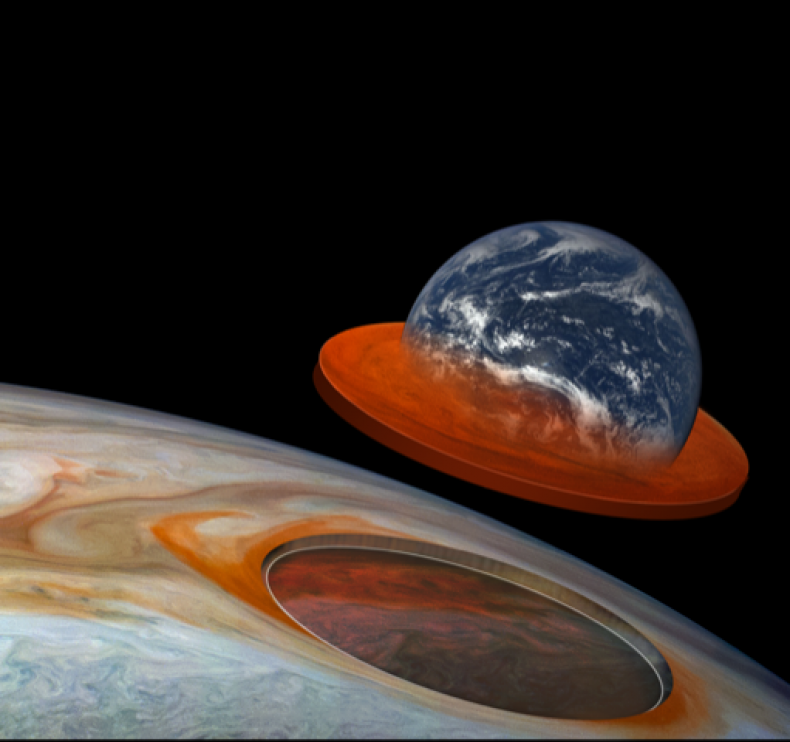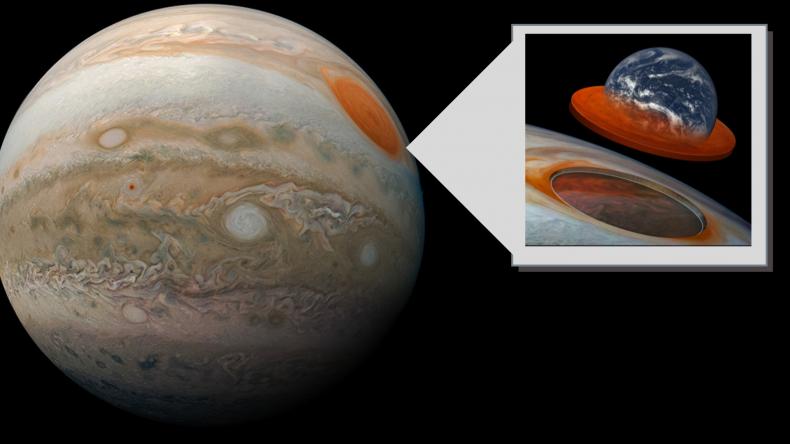New observations conducted by NASA's Juno spacecraft have led to the discovery that Jupiter's Great Red Spot is deeper than previously believed. The findings reveal that the storm extends as far as 300 miles down into the atmosphere of the giant planet.
This means that the Great Red Spot, which is the solar system's largest storm, is wide and deep enough to swallow Earth from sea level out to the orbit of the International Space Station, at an altitude of around 250 miles.
Yet, because of its tremendous width of over 10,000 miles, and the fact that the gas giant's atmosphere reaches its center, the team behind the findings still describes the storm as flat like a pancake.
"The Great Red Spot is storming in the southern hemisphere of Jupiter about 20 degrees below the equator, and it is wide enough to swallow the Earth. So this is a huge feature," Marzia Parisi, a scientist at NASA's Jet Propulsion Laboratory in Southern California, said in a press conference. "Despite the wealth of information that we have about the winds that are surrounding the Great Red Spot and the dynamic surrounding the Great Red Spot, we knew very little about its depth."
Parisi, who was part of a Juno mission that used gravity measurements to investigate this and some of Jupiter's other storms, explains that the question of the spot's depth has puzzled scientists for decades with many believing the storm is only "skin deep" at the surface of Jupiter.

The Great Red Spot: An Enduring Storm
Astronomers have been studying the Great Red Spot since at least 1831, when it was first drawn by German amateur astronomer Samuel Heinrich Schwabe, though it could have actually been spotted as early as 1665.
The fact that the storm has lasted for so long has made the Great Red Spot one of the most fascinating and striking features of Jupiter, the solar system's largest planet. Quite how this titanic storm has managed to rage for so long, is still a mystery to researchers.
Observations of the storm have revealed that it rotates anticlockwise and completes a full rotation roughly once every seven days. As it does this, it moves longitudinally in relation to its surroundings, but remains at a steady latitude of 22 degrees south in the gas giant's southern hemisphere.
Juno isn't the only space mission that has allowed scientists to better understand this titanic storm. In September, researchers using the Hubble Space Telescope found that winds at the outer edges of the Great Red Spot were accelerating.

Between 2009 and 2020, the speeds of the counterclockwise winds at the edge of the storm increased by 8 percent, reaching velocities in excess of 400 miles per hour. In comparison, winds at the center of the spot move at a practically leisurely pace, similar to a hurricane here on Earth.
This isn't the only change Jupiter's largest storm is undergoing, however. The Great Red Spot is also shrinking.
In 1979, the Voyager spacecraft measured the spot's length as 14,500 miles with an elongated shape. Since 2012, not only has the spot taken on a more circular shape, but it has also been shrinking at an average rate of 580 miles a year.
Thanks to the Juno spacecraft, which has been orbiting Jupiter since its arrival at the giant planet in 2016 following a five-year journey from Earth, scientists now have a good handle on the Great Red Spot's depth as well as its width.
"It's still a really tall storm. It's a pancake because it's so wide at the top," principal investigator for the Juno mission Scott Bolton said.
With its depth, it may sound strange to hear researchers describe the Great Red Spot as flat like a pancake, but Parisi puts its depth into context. She said: "The Great Red Spot goes pretty deep, but it is still less deep than the jet streams that surround it. They go much deeper, down to around 2,000 miles."
The Gas Giant's Atmosphere
In the press conference, held online, representatives of the Juno mission also explained some of the craft's other recent findings. This included the release of a 3D model of Jupiter's atmosphere created from Juno data.
This model revealed the inner workings of the gas giant's atmosphere, including how cyclones and anticyclones move throughout it, and the physics behind the belts of gas and vapor that move across its surface giving the planet its striking appearance.
"These new observations from Juno open up a treasure chest of new information about Jupiter's enigmatic observable features," director of NASA's Planetary Science Division at the agency's headquarters in Washington, Lori Glaze, said. "Each paper sheds light on different aspects of the planet's atmospheric processes – a wonderful example of how our internationally diverse science teams strengthen understanding of our solar system."
Concluding the press conference, Bolton teased what is next for Juno, saying it would turn its attention to the Jovian moon of Europa.
"We look forward to next year, at about this time, we'll be by flying by really close, just a few, 100 kilometers above Europa's surface, and we'll get very high-resolution images," he said.

https://ift.tt/3nLid5p
Science
No comments:
Post a Comment